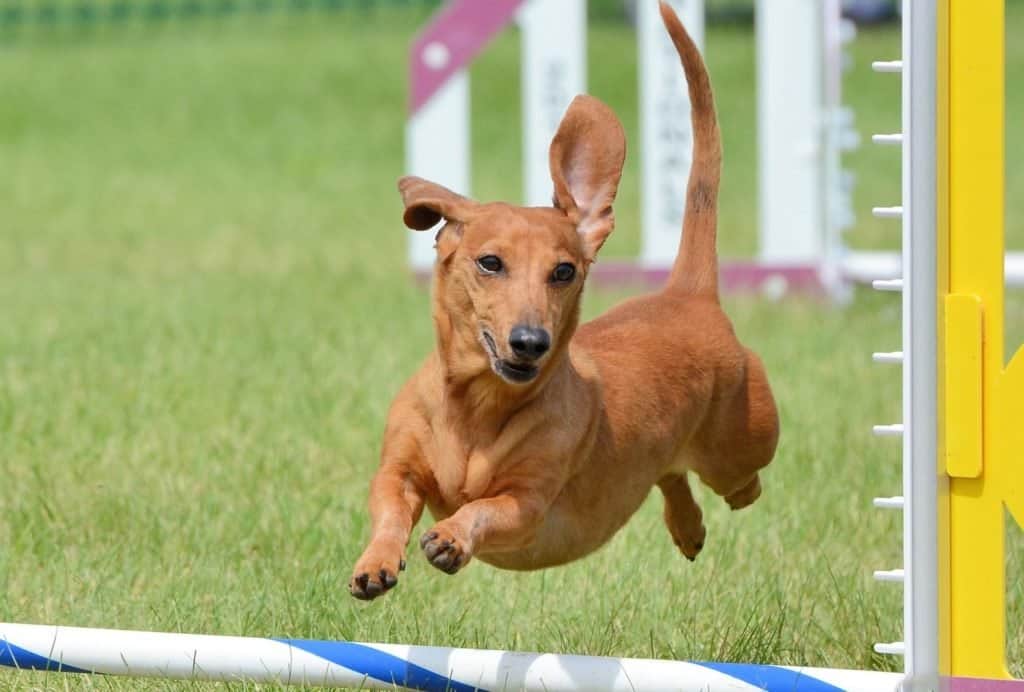
Can small dogs actually hike long distances? If you’re an active small dog owner, this has surely been one of your first questions.
Before I got my Miniature Poodle I’ve actually done a ton of research on small dogs that can hike long distances. I live in an apartment in the city, I cycle a lot and I used to commute by train. All of these were reasons why it just made more sense to get a small dog.
However, I still wanted to bring him on hiking, backpacking and camping trips, just as I would have done with a larger dog.
So, after finding the 10 best small dog breeds, I decided that a Miniature Poodle fits my lifestyle best.
And you wouldn’t believe it if you looked at him. That tiny 10 lb dog has a better stamina than me! We regularly go on one- or two-day hikes where he runs up and down the hill for the whole hike! He’s definitely walking at least 3 times as much as me! He’d even run around during our breaks, if I didn’t take him on a leash.
So, yes, small dogs can definitely hike long distances. A dog’s size really isn’t relevant for their ability to hike. While you might have to take some precautions for small dogs, that might be necessary for their bigger relatives, too. What’s much more important to consider is their breed, age, activity level and overall health.
But, before you dive in head first into your next hiking trip with your dog, make sure to read through these 9 tips to make long distance hiking with your small dog as fun as possible!
Once you’re done with this one, make sure to check out my complete guide for hiking with a small dog for beginners. Over there, I go over everything you need to think about to hit the trail with your small pooch!
Table of Contents
1. Know your dog’s abilities
Note: In general, there is no big difference between a small breed and a large breed dog. For large breed dogs you might have to consider joint problems. So, your small breed dog might even be able to go on longer walks and hikes.
Not every dog will be able or willing to come on hikes with you, though. To find out if your small dog is the hiker type, there are a few guidelines to follow:
Age and Health
If your dog is under 1 year old, he’s not ready for long distance hikes, yet.
As a rule of thumb, a puppy is allowed to walk 5 minutes per month of his age at a time until he’s about 1 year old (for small breed dogs).
Until then your dog’s bones and joints are still relatively soft and longer walks can harm his health.
If your doggo has just surpassed his first birthday, you still shouldn’t rush the hiking training. Start slowly with the preparation (see below) and when he’s about 1.5 years old, it should be fine to go on a first full-day hike.
If you want to learn more about how to prepare a puppy for hiking, check out my article about the 10 things you need to know before hiking with a puppy.
On the other hand, if your dog is over 10 years old, he’ll probably be tired after half a day of hiking.

Breed
Some breeds are physically unable to partake in hiking or other demanding exercises.
For instance short-nosed, brachycephalic breeds (e.g. French Bulldogs or Pugs) have shorter airways which can lead to them overheating very quickly. It is generally recommended for those breeds to only walk 30 minutes at a time.
Very short breeds such as Chihuahuas and Pekingese will probably also not be able to walk for several hours. They simply lack the muscle structure that’s required for demanding walks.
And lastly, dogs with short legs and long back (e.g. Dachshund) need special attention because climbing over obstacles or jumping off them can significantly hurt their backs.
However, there are always exceptions. Especially if your dog is a mixed-breed, it is very well possible that he’s perfectly fine with hiking.
On the other hand, Terriers are generally very active and energetic dogs who will love to come on long distance hikes with you. Same counts for Poodles, Corgis and of course Shetland Sheepdogs. Check out my list of the 7 best small breed active dogs for a good overview.
Personality
Just as humans, not every pup likes long walks, let alone hikes. Some are couch potatoes and simply prefer staying inside, sleeping and cuddling.
If you’re not sure if your dog is the hiking kind or not, just start building up their stamina and you’ll soon know where their threshold is.
2. Build up your dog’s stamina
Just as for people, your dog also has to get in shape. If your dog is only used to walking for about 30 minutes at a time, he’ll have a hard time coming on a long distance trek.
So, start with slightly longer walks, an hour daily, then on certain days of the week two or three hours. Eventually, your dog will have no problem keeping up with you even on multi-hour walks.
That’s when you can follow through with the next step: more difficult terrain. So, just take the same length of the longer walks that you have done on flat terrain and go to a slightly steeper or more stony area.

If your dog is used to going on 3 hour treks or more on strenuous terrain, it should be no problem to take him even on a multi-day hike. But keep in mind that your doggo needs continuous practice. If you want to go hiking on a regular basis, then also do regular shorter (hourly) exercise walks on different terrain.
Note: some dogs are fitter by breed than others. Miniature Poodles, for instance, can do multi-hour treks without much exercise because they are constantly so full of energy! On hikes they’re happy when they can finally use it. Baloo can easily come on a 5-hour trek and run up and down the whole time and still have energy in the evening! Others might need a little more practice.

3. Visit the vet
Before you plan on going on a longer trek or hike, please visit your veterinarian well in advance. She can perform a health check and tell you if your small dog is physically able to go hiking. Also, she can help you set up a training plan if your pup is still young or not used to long walks.
Please consider that this post only acts as a guideline. To confirm your dog’s abilities, always talk to your veterinarian!
4. Practice overcoming obstacles
Another important preparation exercise is to practice overcoming obstacles with your dog. This can be walking over different objects (boulders, ramps or bridges), jumping over logs etc. or walking on small paths.
Ideally you could already train overcoming obstacles in your dog school. If not, dog agility training is also a good way to practice.
If your dog is a rather timid one, just start by walking through the woods and try to take every obstacle until your pooch masters them with ease.

5. Bring enough food and water
Since your dog will consume a lot of energy during a hike, it’s important to have the right food and the right quantity with you so that your dog can refill his batteries. Please consult your vet for the right kind and amount of food for hiking trips, in case you’re not sure.
Personally, I bring Baloo’s normal food and just make sure it’s definitely enough for the time we’re hiking. Plus, I bring lots of yummy treats in order to make sure he at least eats those. He’s a little picky eater and being in unfamiliar surroundings sometimes leads to him not eating much or at all…
Of course you should also always have enough water for you and your dog, especially on warmer days. I really like the collapsible bowls for your pup’s meals. They are so convenient, lightweight and don’t need a lot of space.
6. Obedience training
Before you go on a long distance hike with your small dog it’s essential that he knows some basic obedience.
Even though your dog has to be on a leash on a lot of trails, I prefer it much more if he can go off-leash. This way he can sniff around wherever he likes and go at his own pace.
Where off-leash hiking is possible, it’s crucial that your pupper knows some basic commands. This includes, “sit”, “down”, “stay” and “heel”, plus he needs a super solid recall! These commands should be trained on walks before you go on a hike.
If you’d like to let your dog off leash, make sure to check out my preparation guide on hiking with a dog off-leash, first.
And also if he’s walking on a leash, it’s much more comfortable if your dog knows how to behave. Especially with small dogs, obedience training is sometimes neglected.
If you plan on taking your furry friend hiking regularly, I strongly recommend to start training as soon as possible!

7. Choose the right trail and time
If your dog is semi active it’s probably better to choose a less demanding trail. If you have a super active dog like Baloo, though, you can easily go hiking with him in the mountains.
We’ve been hiking in the mountains on numerous occasions and, believe me, he’s much faster than me, climbing and jumping over rocks and boulders as if it was nothing.
So, it’s important to take your dog’s skills and stamina into consideration when you’re planning your hike.
Another important fact to consider is the weather.
In summer it’s usually fine to go hiking in the mountains because it is much cooler. If it’s over 77° Fahrenheit (25° Celcius) and the sun is shining, your dog can overheat quickly. So, make sure to walk in the shade as much as possible, taking regular breaks and let your dog drink repeatedly.
If your dog is getting too hot, he might actually suffer from a heat stroke. Check out these 13 symptoms for a heat stroke in dogs to understand how to prevent it and what to do about it if it already happened!
During the colder seasons you have to watch out that your pupper isn’t getting cold. He should never be shivering. If you plan on trekking or hiking on a rainy or snowy day it’s best to bring a coat for your small dog along.
8. Watch out for weariness and exhaustion
It’s important to note that many dogs won’t stop when they’re exhausted! They’ll continue to try and keep up with you.
Therefore, you must watch out for signs of weariness, such as excessive panting, wobbly legs or if they’re far behind you all the time. Excessive thirst, lip licking and him not acting like himself are also common signs.
In this case consider taking more or longer breaks or simply carrying him in his backpack carrier for a while.
In order to get the full picture, head over to these 18 exhausted dog symptoms. Not all of them are that obvious!

9. Bring a dog backpack carrier
And last but not least, I highly recommend bringing a backpack carrier along for your small dog.
It’s just a great safety measure. If anything happens or he tires out quicker than you thought, just put him in the carrier and he can take a break while you continue hiking.
In case you’re not sure which model to get, check out the 6 best dog backpack carriers for hiking.
Conclusion
So, as you can see small dogs can absolutely hike long distances!
In fact, most small dogs will probably easily hike 10 or 15 miles in a day (16 to 24 km) if you observe these 9 tips listed here.
Keep in mind that a lot of it depends on your dog’s health and stamina, though. But also the kind of trail plays a big role. 15 miles on flat terrain are obviously much easier than 10 miles in the mountains.
So, make sure to prepare your small dog a slowly get him used to long distance hiking.
*Disclosure: This post may contain affiliate links, meaning, I get a commission if you decide to make a purchase through one of my links, at no cost to you.

